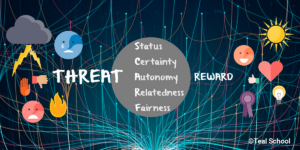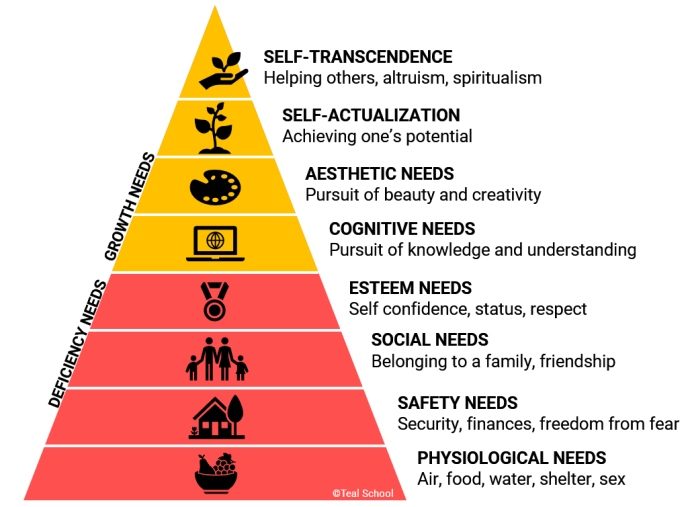Do you know your brain? You probably know a little something. Like how it works through firing neurons in complex neural networks, and how the brain chemistry: hormones like dopamine, serotonin and adrenaline, affect how you feel. You probably know that different areas of the brain are dedicated to e.g. language, vision etc, and you most likely know about how the brain’s left hemisphere is logic and strategic, and the right is emotional and creative.
You might have learned a lot more of course, like how your neocortex and especially the frontal lobe is your thinking, rational, more human part of the brain and that we have a reptile brain which is responsible for body control and survival instincts, stearing us away from threats (like a T-rex, lion or earth quake) and towards rewards (like food and sex).
This is of course very simplified – our whole brain is a human brain where all parts work together to form our experience of the world and of ourselves. But, let’s stay with this model of the brain for a minute. Although simplistic it offers us an easy way of understanding some of our feelings, reactions, needs and behaviours.
The model was suggested in the 1960’s by Paul MacLean and is called the Triune Brain model. It describes a three-parted brain. Other than the reptile brain (basal ganglia) and the human brain (neocortex) we also have a mammal part in our brain (the limbic system).
The evolutionary step towards becoming mammals meant survival wasn’t only connected to staying away from predators and getting food, but to being a part of a caring family or flock. And since survival is a pretty good thing, the mammal brain developed emotions, and basic needs that are social and emotional.
The SCARF model by David Rock describes these basic social needs:
Status – one’s place in the group, e.g. being seen as competent. I’m valuable.
Certainty – being able to predict the future, to be informed. I know what to expect.
Autonomy – a sense of control over one’s own environment. I have a choice.
Relatedness – a sense of connection and security, fitting in. I belong.
Fairness – being treated fairly, same rules for all. I am treated with respect.

The basic reactions to these needs being met or not met is however the same. The same “fight or flight” response from the “reptile brain” can be triggered by things like being excluded from a group or being treated unfairly, not only from being physically attacked or threatened.
We all have these basic needs but how much of a threat response we get when the needs are not met differs between individuals. Childhood experiences like attachment issues and trauma are related to strong threat reactions. How happy, relaxed and content we feel when the needs are met is also individual. One thing is common though: the reaction to a threat is 5-6 times larger than the reaction to a positive trigger.
It all has to do with survival – but in today’s (not so very empathetic and caring, and more competitive and unfair) world this unfortunately means a lot of triggered threat responses, which in turn can lead to conflicts, stress and eventually burnout.
SCARF in school
Knowledge of the social needs described in the SCARF model is, in my opinion, one of the most important factors when designing a school and school experience for the kids. If there is a threat present — whether it’s highly noticable like conflicts or bullying, or more subtle like an “I’m not good enough”-ache — much less learning and development will take place. A brain that is feeling threatened loses some (or a lot) of the analytical and creative neocortex ability, which is needed in most school work.
A school designed to fulfill SCARF needs for all kids, and adults, will be a school with better results on both cognitive and emotional development, as well as a school with more wellbeing and better relations.
If you wonder how this can be done, scroll back up and read the description of what SCARF stands for again, and ask yourself – how can I get both kids and adults in this school to feel: I’m valuable, I know what to expect, I have a choice, I belong and I am treated fairly and with respect?
Other needs
This is a picture of an extended Maslow pyramid, describing basic, social and growth needs. Although the hierarchy can be questioned (it is possible to have “higher” needs although the more basic isn’t met) it is a model that is good to reflect upon when designing a school.

Traditional schools are putting a lot of emphasis on cognitive needs (or rather; needs are hardly talked about at all), but there’s really nothing that stops a school from trying to fulfill needs on all of these levels.
Offer good, healthy food and exercise, try your hardest to offer a psychologically safe environment (might e.g. mean smaller schools are better), work with building a team of your class, teach the kids to show gratitude towards each other, offer more time with creative work, talk about dreams and goals, and do project work that is related to helping others, to co-create a sustainable world etc.
You will probably discover that even though this might mean you spend less time in pure knowledge sharing, you still see a much better result in the kids’ cognitive ability and understanding.
Written by Sarah Rosendahl, earlier published 3 Feb. 2020